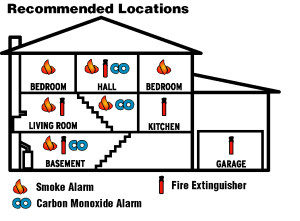Smoke and carbon monoxide alarms save lives. Smoke and carbon monoxide alarms that are properly installed and maintained play a crucial role in reducing deaths and or injuries. If there is a fire in your home or a gas appliance not operating properly these devices will notify you to get out fast and call emergency authorities.
Carbon Monoxide (CO) Detectors
First i’d like to talk about Carbon Monoxide (CO) dubbed the “silent killer,” carbon monoxide is an odorless, tasteless gas that is highly toxic. It’s the byproduct of any fuel-burning appliances such as a stoves, dryers, furnaces, water heaters, wood & gas burning fireplaces or idling vehicles. Carbon monoxide is the leading cause of accidental poisonings, according to fire officials. Exposure can cause dizziness, severe headache, unconsciousness or death. On average, about 400 people in the United States die and 20,000 people are injured each year from CO poisoning.

Wisconsin became the 24th state back in 2011 to mandate installation of carbon monoxide (CO) alarms. The law requires a carbon monoxide alarm on each level of all one- and two-family residences having any fuel burning appliance, fireplace or attached garage make sure to follow the manufacturer’s guidelines on the package first and foremost to ensure you have properly installed your detector. Moreover, if you’re unsure whether you need an additional detector or it is somewhat questionable, keep in mind detectors are fairly inexpensive. It’s better to be safe than sorry, right? Another very important factor is the lifespan of the doctors in your home Many manufacturers will state the limited life span somewhere in their manual; however, it’s usually not prominent. The presence of a CO alarm may give you a false sense of security. It could even lead to unsafe combustion practices, thinking that if the air becomes poisonous, the alarm will warn you. Check the manufacturer’s instructions. If your CO detector was put into use before 2007, it probably needs to be replaced.

Smoke Detectors
It’s important to have enough smoke alarms in your home. Fire research has demonstrated that with today’s modern furnishings, fires can spread much more rapidly than in the past when more natural materials were used. Because of this, having a sufficient number of properly located smoke alarms is essential to maximize the amount of available escape time. Current safety guidelines/laws recommend installing smoke alarms inside each bedroom, outside each sleeping area and on every level of the home, including the basement. On levels without bedrooms, install alarms in the living room (or decor family room) or near the stairway to the upper level, or in both locations.

The two most commonly recognized smoke detection technologies are ionization smoke detection and photoelectric smoke detection.
Ionization smoke alarms are generally more responsive to flaming fires.How they work: Ionization-type smoke alarms have a small amount of radioactive material between two electrically charged plates, which ionizes the air and causes current to flow between the plates. When smoke enters the chamber, it disrupts the flow of ions, thus reducing the flow of current and activating the alarm.
Photoelectric smoke alarms are generally more responsive to fires that begin with a long period of smoldering (called “smoldering fires”).
How they work: Photoelectric-type alarms aim a light source into a sensing chamber at an angle away from the sensor. Smoke enters the chamber, reflecting light onto the light sensor; triggering the alarm
The life expectancy of smoke alarms is generally 10 years, after which point their sensors can begin to lose sensitivity. The test button only confirms that the battery, electronics, and alert system are working; it doesn’t mean that the smoke sensor is working. Every smoke alarm has a expiration date and should be clearly marked so replacement can be made as needed.
Smoke alarms are only effective as how they are maintained like most anything else here are some scary statistics as provided by NFPA
Smoke alarms by the numbers
- In 2009-2013, smoke alarms sounded in more than half (53%) of the home fires reported to U.S. fire departments.
- Three of every five home fire deaths resulted from fires in homes with no smoke alarms or no working smoke alarms.
- No smoke alarms were present in more than one-third (38%) of the home fire deaths.
- One of every five (21%) of the home fire deaths, smoke alarms were present but did not sound.
- In reported home fires in which the smoke alarms were present but did not operate, almost half (46%) of the smoke alarms had missing or disconnected batteries. Nuisance alarms were the leading reason for disconnected smoke alarms.
For more information regarding smoke alarms please click here

